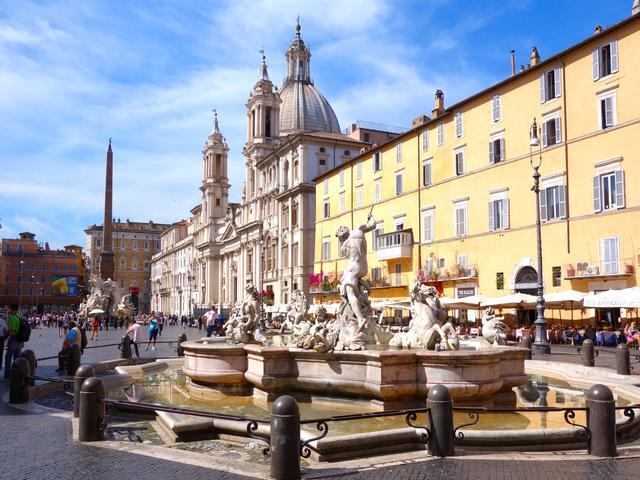Navona Square

Piazza Navona is a stunning square located in the heart of Rome, Italy, with a rich history dating back to ancient Roman times. Originally built on the site of Domitian's Stadium in the 1st century AD, the square has evolved over the centuries into a vibrant hub of art, culture, and history. The name "Navona" is believed to have originated from the term "avone" or "navone," derived from the original "Circus Agonalis," where ancient Romans gathered to watch games and competitions.
In the late 15th century, Piazza Navona was officially designated as a public space, marking the beginning of its transformation into a masterpiece of Roman baroque architecture and art. One of the most iconic landmarks in the square is the Fontana dei Quattro Fiumi, or Fountain of the Four Rivers, designed by the renowned sculptor Gian Lorenzo Bernini in 1651. The fountain features four larger-than-life statues representing the four major rivers of the continents known at the time: the Nile, Ganges, Danube, and Rio de la Plata. At the center of the fountain stands an Egyptian obelisk, adding to the grandeur and symbolism of the masterpiece.
Another architectural gem in Piazza Navona is the church of Sant'Agnese in Agone, designed by Francesco Borromini and Girolamo Rainaldi. The church's stunning facade and interior showcase the intricate baroque style, with elaborate decorations and frescoes that captivate visitors with their beauty and detail. Adjacent to the church is the Palazzo Pamphili, a grand palace that once belonged to the powerful Pamphili family. The palace overlooks the square and features a magnificent long gallery designed by Borromini and adorned with frescoes by Pietro da Cortona.
As you wander through Piazza Navona, you'll also encounter other notable sculptures and architectural marvels, each contributing to the square's unique charm and historical significance. From street performers and artists to bustling cafes and shops, the square offers a lively atmosphere that invites visitors to immerse themselves in the rich tapestry of Roman culture and heritage. Whether you're admiring the fountains, exploring the churches, or simply soaking in the vibrant ambiance, Piazza Navona is a must-visit destination for anyone seeking to experience the beauty and history of Rome.
© ChatGPT 3.5
Piazza Navona has two other fountains. At the southern end is the Fontana del Moro with a basin and four mermen sculpted by Giacomo della Porta (1575) to which, in 1673, Bernini added a statue of a Moor, or North African Muslim, wrestling with a dolphin. At the northern end is the Fountain of Neptune (1574) also created by Giacomo della Porta; The statue of Neptune, by Antonio Della Bitta, was added in 1878 to create a balance with La Fontana del Moro.
During its history, the piazza has hosted theatrical events and other ephemeral activities. From 1652 until 1866, when the festival was suppressed, it was inundated every Saturday and Sunday in August in the elaborate celebrations of the Pamphilj family. The level of the pavement was raised in the 19th century, and in 1869 the market was moved to the nearby Campo de' Fiori. A Christmas market takes place in the Piazza square.